Sturmabteilung (SA)
Emil Maurice joined the Nazi Party in 1919 (member No. 19). He became a close friend of Adolf Hitler and in 1920 became head of his bodyguard at public meetings. According to Alan Bullock, the author of Hitler: A Study in Tyranny (1962): "The strong-arm squades were first formed in the summer of 1920, under the command of an ex-convict and watchmaker, Emil Maurice, but their definitive organization dates from August 1921, when a so-called Gymmnastic and Sports Division was set up inside the Party." This group eventually became known as the Sturmabteilung (Storm Detachment). (1)
Hitler's stormtroopers were often former members of the Freikorps (right-wing private armies who flourished during the period that followed the First World War) and had considerable experience in using violence against their rivals. The SA wore grey jackets, brown shirts (khaki shirts originally intended for soldiers in Africa but purchased in bulk from the German Army by the Nazi Party), swastika armbands, ski-caps, knee-breeches, thick woolen socks and combat boots. (2)
Kurt Lüdecke and the SA
In 1922 Kurt Lüdecke joined the Nazi Party. Lüdecke considered the Sturmabteilung as "little better than gangs". He approached Hitler and suggested that he should form an elite, well-disciplined company of Storm Troopers. He thought that their example might prove an inspiration to the rest of the SA. "Hitler listened to my plan and told me to go ahead and form a troop, if that was what I wanted." (3)
James Pool points out: "Lüdecke began recruiting, accepting only the toughest and most able-bodied men who had either served in the war or had some military training. Two former Army officers were appointed as platoon leaders. A number of young students began to join the troop. A band with four drummers and four fifers was organized. Drills were held regularly. Every Wednesday night the entire company would assemble in a room Lüdecke had rented in a cafe on Schoenfeldstrasse, where he lectured his men on the political aims of the Nazi Party. Every new member took an oath of allegiance on the swastika flag and pledged loyalty to Hitler." (4)
Kurt Lüdecke also bought the uniforms and other equipment for the men. Except for a few small details, the appearance of Lüdecke's men was almost indistinguishable from regular Army troops. By the end of December 1922 about 100 men had enlisted in Lüdecke company, and over forty regular Army soldiers had pledged their loyalty in secret. "I was able through my connections with certain Reichswehr officers to gain the privilege of using the drill-hall of the Second Bavarian Regiment." (5)
Accompanied by bands of musicians and carrying swastika flags, they would parade through the streets of Munich. At the end of the march Hitler would make one of his passionate speeches that encouraged his supporters to carry out acts of violence against Jews and his left-wing political opponents. The SA was assigned the task of winning the battle of the streets against the Communists. Hitler believed that the "possession of the streets in the key to the power of the state." Albert Speer claims that his mother joined the Nazi Party after seeing a SA parade in Heidelberg. (6)
The SA (also known as stormtroopers or brownshirts) were instructed to disrupt the meetings of political opponents and to protect Hitler from revenge attacks. They were often former members of the Freikorps and had considerable experience in using violence against their rivals. (7)
Ernst Röhm
Ernst Röhm played an important role in recruiting these men, and became the SA's first leader. Röhm's biographer, Paul R. Maracin, has pointed out that he played a vital role in arming the SA: "After the war a large arsenal was left by the German Army, and Röhm was one of several officers who conspired to divert and cache the arms. The German government had promised the Allies that the guns, ammunition, and vehicles would be dutifully destroyed, and according to the peace treaty, this should have been done. However, in some instances (with the connivance of some Allied officers attached to control commissions), these arms were stored for future use and would later he issued to members of the Freikorps and the SA. As an officer, Röhm had the reputation of a man who resolutely stood by his subordinates, while acting as a buffer between them and his superior officers. For all his dedication as a soldier, he was, paradoxically, a person who casually arranged for the murder of informants who tried to reveal the whereabouts of his hidden arsenals." (8)

Louis L. Snyder has argued: "From its earliest days Hitler regarded the SA as a political and not as a military force. He considered his Brownshirts shock troops for a revolution that was never to be made. His problem was to maintain the spirit of the of the SA without allowing it to move into revolutionary action. Above all, he was determined to keep it from a conflict with the Army. Röhm, on the other hand, saw the SA not only as the backbone of the Nazi movement but as the nucleus of a revolutionary army." (9)
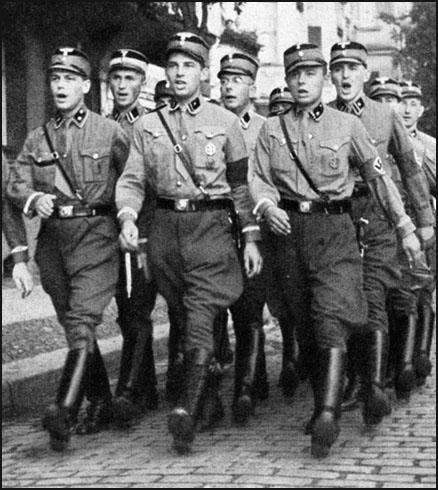
In April 1925, Ernst Röhm came into conflict with Adolf Hitler. He complained that he could not stand the "flatterers" who "unscrupulously crowded around", exploiting his vanity, feeding him on illusions and "venturing no word of contradiction". Röhm decided "to speak openly to his friend as a loyal comrade". Hitler reacted badly and the two men had a vicious argument. Röhm wrote a letter to Hitler begging for the resumption of their old personal friendship, but Hitler did not answer. "Thus the real creator of Adolf Hitler parted with his creature who had grown too great and thought himself even greater." (10)
On 14th February 1926, Röhm attended the Bamberg Party Congress where Adolf Hitler attempted to settle to Nazi Party program. There had been a clash of opinion between northern and southern leaders about future policy. Ernst Röhm, Gregor Strasser and Joseph Goebbels represented the urban, socialist, revolutionary trend, whereas Gottfried Feder reflected rural, racialist and populist ideas. At the conference Hitler made a two-hour speech where he opposed the socialism of Röhm, Goebbels and Strasser. He argued that the NSDAP must not help Communist-inspired movements. (11)
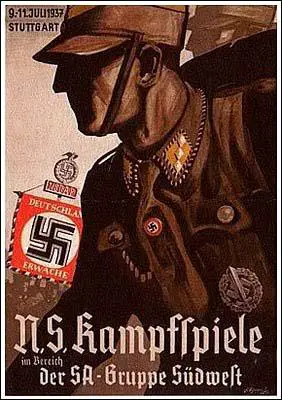
Goebbels was initially appalled by the speech and noted in his diary: "I feel devastated... Hitler a reactionary? Amazingly clumsy and uncertain... Italy and England natural allies... Short discussion. Strasser speaks. Hesitant, trembling, clumsy, the good honest Strasser. God, how poor a match we are for those swine... Probably one of the greatest disappointments of my life. I no longer believe fully in Hitler." (12)
Franz Pfeffer von Salomon
Goebbels and Strasser finally accepted these arguments and in return they received promotion. Strasser was appointed as Propaganda Leader of the NSDAP and Goebbels became Gauleiter of Berlin. However, Röhm made it clear that he still retained his faith in socialism. As a result Hitler removed him as leader of the Sturm Abteilung (SA) and replaced him with Franz Pfeffer von Salomon.
According to Michael Burleigh, the author of The Third Reich: A New History (2001): "Franz Felix Pfeffer von Salomon... brief was to check its aspirations to quasi-military status by firmly subordinating it to the Party's political and propaganda goals. The SA was to perform two functions: to rough up opponents during elections, a practice Hitler seems to have admired across the Atlantic, and to assert the Nazi presence on the streets." Hitler wrote to Pfeffer: "We have to teach Marxism that the future master of the streets is National Socialism, just as one day it will be master of the state." (13)
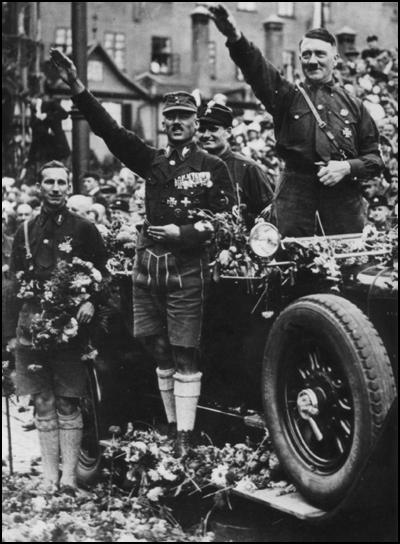
It has been argued: "Pfeffer added orderliness and traditional army drill to SA formations to try to give parade-ground impressiveness and the glamour of a military appearance. His object was to make the SA an instrument of propaganda rather than a gang of bullies. It was Pfeffer who trained the SA in the mass parades and salutes with the raised arm, and the massed shout Heil Hitler! that became a feature of Party rallies." (14)
Alan Bullock, the author of Hitler: A Study in Tyranny (1962) has argued that Pfeffer became just as difficult as Röhm had been. "Whatever steps Hitler took, however, the S.A. continued to follow its own independent course. Pfeffer held as obstinately as Röhm to the view that the military leadership should be on equal terms with, not subordinate to, the political leadership. He refused to admit Hitler's right to give orders to his Stormtroops. So long as the S.A. was recruited from the ex-service and ex-Freikorps men who had so far provided both its officers and rank and file, Hitler had to tolerate this state of affairs." (15)
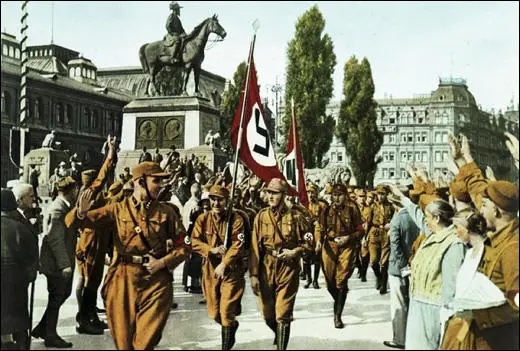
On 2nd September 1930 Hitler relieved Franz Pfeffer von Salomon of his command. Hitler assumed temporary leadership of the Sturmabteilung but decided to forgive Röhm for past indiscretions. A telegram was dispatched from Munich to La Paz. By the end of 1930 Röhm had returned to his native Germany, and in January 1931 he was named Chief of Staff of the SA. In just over a year he expanded it from 70,000 to 170,000 members. (16)
Horst Wessel
Horst Wessel was a member of the SA in Berlin. He became a leader of Storm Unit 5, and developed a "particularly aggressive in leading incursions into Communist territory and giving inflammatory speeches in an atmosphere of confrontation". The group targeted their violence on young members of the German Communist Party (KPD). (17)
In September 1929, Wessel met Erna Jänicke, an 18-year-old prostitute. He moved into her apartment in Große Frankfurter Straße. It has been claimed by Erika Mann that was Wessel was Jänicke's pimp. "While his mistress was making money, he was breaking up meetings and taking part in the bloody street fights between workers and Nazi toughs that were then so common". (18) However, historians such as William L. Shirer, have pointed out that Mann was a prominent anti-Nazi, and though this charge may have been exaggerated... he (Wessel) definitely consorted with pimps and prostitutes". (19)
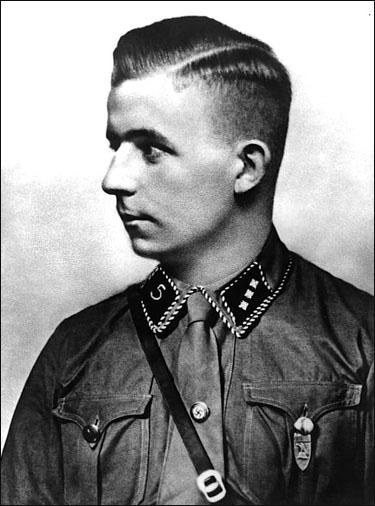
In November, 1929, several members of the SA and the KPD were killed in street fighting. It was claimed that Wessel's gang was responsible for the murder of several men. KPD posters appeared with pictures of Wessel that had the caption: "Note that face! Horst Wessel Storm Leader - Murderer of Workers". (20)
On 28th December, 1929, Horst's brother, Werner Wessel, died in a skiing accident. Joseph Goebbels arranged a large public funeral for Werner, who was also a senior figure in the SA. Over 500 men with torches marched past the KPD's headquarters on the way to the cemetery. Goebbels wrote: "It was gripping and shattering. I could hardly speak." (21)
Wessel's landlady was Elisabeth Salm, whose late husband had been an active Communist. After a few months, there was a dispute between Salm and Wessel over unpaid rent. She approached some of her former husband's friends in the KPD to help have Wessel removed from the apartment. Albrecht Höhler, a member of the Red Front Fighters' League, agreed to organize the eviction. (22)
On 14th January, 1930, while the eviction was taking place, Höhler shot Wessel in the face. Jänicke identified Höhler as the gunman and he was arrested. (23) The KPD claimed that the shooting had been motivated by a jilted pimp. Salm told journalists that the conflict was an example of "two men fighting over a retired tart". (24)
Joseph Goebbels visited Horst Wessel four times in hospital. He had survived an operation undertaken to stop the internal bleeding, but the surgeon had not managed to remove the bullet lodged in front of the cerebellum. Goebbels wrote in his diary that Wessel told him, "One has to keep going! I'm happy". (25)
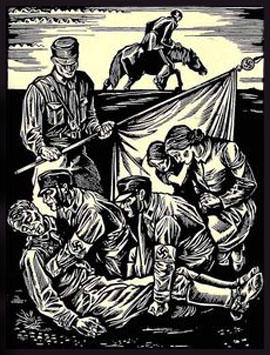
Over the next few days there was a propaganda war in Berlin. The left-wing newspaper, Die Rote Fahne, argued that Wessel was a pimp and that Höhler had no connection with the KPD. (26) Goebbels dismissed this claim and he wrote in Der Angriff that the murderers were communists and they needed to be "crushed to a pulp". (27)
Horst Wessel died on 23rd February, 1930. Goebbels attempted to make the funeral the occasion of impressive mass demonstrations but the police refused to issue a permit. However, every attempt was made to get as many SA men on the streets as possible. Goebbels wrote in his diary that the funeral was attended by around 30,000 people. (28)
The coffin draped with a swastika flag was lowered into the grave. Goebbels spoke of Wessel as a "Christ like" figure whose deeds proclaimed, "Come unto me, I will redeem you... One man must be an example and offer himself as a sacrifice". Goebbels used Wessel as an example to other SA men. "Through sacrifice to redemption... through struggle to victory." Goebbels went on to say: "And when the SA assembles for the great roll call, when every man's name is called, the Führer will also call your name, Comrade Wessel! And all, all SA men will answer with one voice, Here!... Wherever Germany is, there you are as well, Horst Wessel!" (29) Communists carried banners saying "Wessel the Pimp" and the funeral was followed by street fighting. (30)
Wessel's mother gave Goebbels her son's papers. This included the song lyric, The Flag Held High, that had already been adopted by the Berlin SA. Like many Nazi songs, it was an existing tune with new words. The song was sung at Wessel's funeral and eventually became one of the most important features of Nazi Party meetings. (31)
The Growth of the SA
Adolf Hitler used Röhm's brownshirts to break-up meetings held by the German Communist Party (KPD) and the Social Democratic Party (SDP). By 1932 there were nearly 2 million members of the SA and they easily won the "battle of the streets against the Communists". (32)
When Adolf Hitler became Chancellor in 1933 Ernst Röhm made a speech where he stated: "A tremendous victory has been won. But not an absolute victory! The SA and the SS will not tolerate the German revolution going to sleep and being betrayed at the half-way stage by non-combatants. Not for the sake of the SA and SS but for Germany's sake. For the SA is the last armed force of the nation, the last defence against communism. If the German revolution is wrecked by the reactionary opposition, incompetence, or laziness, the German people will fall into despair and will be an easy prey for the bloodstained frenzy coming from the depths of Asia. If these bourgeois simpletons think that the national revolution has already lasted too long, for once we agree with them. It is in fact high time the national revolution stopped and became the National Socialist one. Whether they like it or not, we will continue our struggle - if they understand at last what it is about - with them; if they are unwilling - without them; and if necessary - against them."
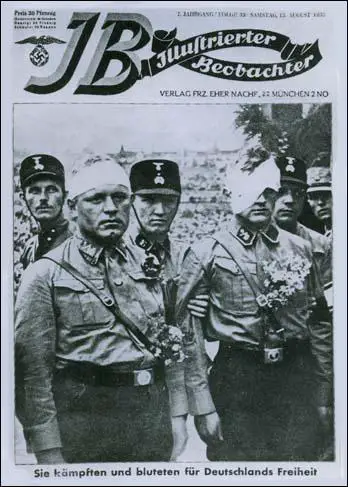
By 1934 Hitler appeared to have complete control over Nazi Germany, but like most dictators, he constantly feared that he might be ousted by others who wanted his power. Albert Speer pointed out: "After 1933 there quickly formed various rival factions that held divergent views, spied on each other, and held each other in contempt. A mixture of scorn and dislike became the prevailing mood within the party. Each new dignitary rapidly gathered a circle of intimates around him. Thus Himmler associated almost exclusively with his SS following, from whom he could count on unqualified respect... As an intellectual Goebbels looked down on the crude philistines of the leading group in Munich, who for their part made fun of the conceited academic's literary ambitions. Göring considered neither the Munich philistines nor Goebbels sufficiently aristocratic for him and therefore avoided all social relations with them; whereas Himmler, filled with the elitist missionary zeal of the SS felt far superior to all the others." (33)
Hitler was especially afraid of Röhm and did not give him a post in his government. Röhm complained to Herman Rauschning: "Adolf is a swine... He only associates with the reactionaries now. His old friends aren't good enough for him. Getting matey with the East Prussian generals. They're his cronies now... Are we revolutionaries or aren't we? The generals are a lot of old fogies. They will never have a new idea... I don't know where he's going to get his revolutionary spirit from. They're the same old clods, and they'll certainly lose the next war." (34)
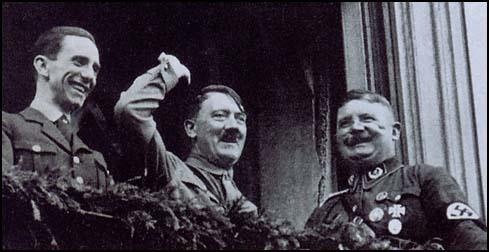
Industrialists such as Albert Voegler, Gustav Krupp, Alfried Krupp, Fritz Thyssen and Emile Kirdorf, who had provided the funds for the Nazi victory, were unhappy with Röhm's socialistic views on the economy and his claims that the real revolution had still to take place. Walther Funk reported that Hjalmar Schacht and his friends in big business were worried that the Nazis might begin "radical economic experiments". (35)
General Werner von Blomberg, Hitler's minister of war, and Walther von Reichenau, chief liaison officer between the German Army and the Nazi Party, became increasingly concerned about the growing power of Ernst Röhm and the Sturmabteilung (SA). They feared that the SA was trying to absorb the regular army in the same way that the SS had taken over the political police. (36) Reichenau was concerned by a letter he received from Röhm: "I regard the Reichswehr now only as a training school for the German people. The conduct of war, and therefore of mobilization as well, in the future is the task of the SA." (37)
Many people in the party disapproved of the fact that Röhm, and many other leaders of the SA, including his deputy, Edmund Heines, were homosexuals. Konrad Heiden, a German journalist who investigated these rumours later claimed that Heines was at the centre of this homosexual ring. "The perversion was wide-spread in the secret murderers' army of the post-war period, and its devotees denied that it was a perversion. They were proud, regarded themselves as 'different from the others', meaning better." (38)
Rudolf Diels Report
Göring suggested to Rudolf Diels, the head of the Gestapo, that he was too close to Röhm. "I warn you, Diels, you can't sit on both sides of the fence." Göring ordered Diels to carry out an investigation into Röhm and the SA. He reported back with details of homosexual rings centering on Röhm and other SA leaders, and on their corruption of Hitler Youth members. Göring complained to Diels: "This whole camarilla around Chief of Staff Röhm is corrupt through and through. The SA is the pacemaker in all this filth (in the Hitler Youth movement). You should look into it more thoroughly." (39)
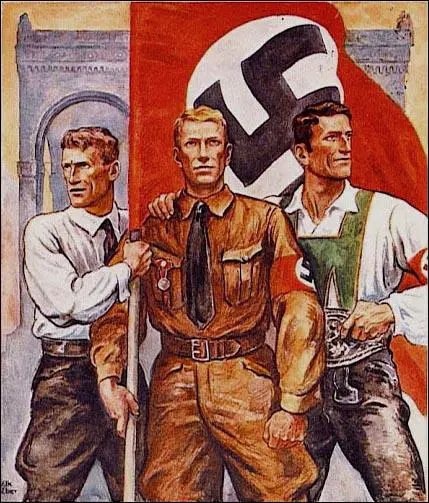
Diels presented his report to Adolf Hitler in January 1934 at his retreat at Obersalzberg. Diels provided information that Röhm had been conspiring with Gregor Strasser and Kurt von Schleicher against the government. It was also suggested that Röhm had been paid 12 million marks by the French to overthrow the Nazi government. (40) Hitler was furious and stated that "it is incomprehensible that Strasser and Schleicher, these arch-traitors, have survived to this day." After the meeting had ended Göring turned to Diels and said: "You understand what the Führer wants? These three must disappear and very soon." (41) He added that Strasser "can commit suicide - he is a chemist after all". (42)
Richard Overy has claimed that both Strasser and Von Schleicher were both politically inactive and posed no threat to Hitler. (43) Peter Stachura, the author of Gregor Strasser and the Rise of Nazism (1983) believes that Strasser was faithfully keeping a written promise to Hitler that he would renounce politics, shunning his former political associates and doing everything possible to deny rumours that he was involved in any conspiracy. (44)
Night of the Long Knives
In February, 1934, Hitler had a meeting with Group Captain Frederick Winterbotham. Hitler told him that there should be only three major powers in the world, the British empire, the American empire and the future German empire. "All we ask is that Britain should be content to look after her empire and not interfere with Germany's plans of expansion." He then went on to deal with the subject of Communism. "He stood up and, as if he was an entirely different personality, he started to yell in a high-pitched staccato voice... He ranted and raved against the Communists." It was later speculated that Hitler was letting Britain know he intended to purge the left-wing of the Nazi Party. (45)
Heinrich Himmler and Karl Wolff went to visit Ernst Röhm at the SA headquarters at the end of April. According to Wolff he "implored Röhm to dissociate himself from his evil companions, whose prodigal life, alcoholic excesses, vandalism and homosexual cliques were bringing the whole movement into disrepute". He then said with moist eyes, "do not inflict me with the burden of having to get my people to act against you". Röhm, also with tears in his eyes, thanked his old comrade for giving him this warning. (46)
On 11th June 1934, Hjalmar Schacht had a private meeting with the Governor of the Bank of England, his personal friend and business associate, Montagu Norman. Both men were members of the Anglo-German Fellowship group and shared a "fundamental dislike" of the "French, Roman Catholics, Jews". (47) Schacht told Norman that there would be no "second revolution" and that the SA were about to be purged. (48)
On 4th June, 1934, Hitler held a five-hour meeting with Röhm. Afterwards he told his friends that he was convinced that he could rely on Hitler to take his side against "the gentlemen with uniforms and monocles". (49) Louis L. Snyder argues that Hitler had in fact decided to give his support to Röhm's enemies: "Hitler later alleged that his trusted friend Röhm had entered a conspiracy to take over political power. The Führer was told, possibly by one of Röhm's jealous colleagues, that Röhm intended to use the SA to bring a socialist state into existence... Hitler came to his final decision to eliminate the socialist element in the party." (50)
Heinrich Himmler and Reinhard Heydrich worked on drawing up a list of people who were to be eliminated. It was known as the "Reich List of Unwanted Persons". (51) The list included Ernst Röhm, Edmund Heines, Gregor Strasser, Kurt von Schleicher, Hitler's predecessor as chancellor, Gustav von Kahr, who crushed the Beer Hall Putsch in 1923, and Erich Klausener, the President of the Catholic Action movement, who had been making speeches against Hitler. On 24th June, 1934, Klausener had organized a meeting held at Hoppegarten racecourse, where he spoke out against political oppression in front of an audience of 60,000. (52)
On the evening of 28th June, 1934, Hitler telephoned Röhm to convene a conference of the SA leadership at Hanselbauer Hotel in Bad Wiesse, two days later. "The call served the double purpose of gathering the SA chiefs in one out-of-the-way spot, and reassuring Röhm that, despite the rumours flying about, their mutual compact was safe. No doubt Röhm expected the discussion to centre on the radical change of government in his favour promised for the autumn." (53)
At around 6.30 in the morning of 30th June, Hitler arrived at the hotel in a fleet of cars full of armed Schutzstaffel (SS) men. (54) Erich Kempka, Hitler's chauffeur, witnessed what happened: "Hitler entered Röhm's bedroom alone with a whip in his hand. Behind him were two detectives with pistols at the ready. He spat out the words; Röhm, you are under arrest. Röhm's doctor comes out of a room and to our surprise he has his wife with him. I hear Lutze putting in a good word for him with Hitler. Then Hitler walks up to him, greets him, shakes hand with his wife and asks them to leave the hotel, it isn't a pleasant place for them to stay in, that day. Now the bus arrives. Quickly, the SA leaders are collected from the laundry room and walk past Röhm under police guard. Röhm looks up from his coffee sadly and waves to them in a melancholy way. At last Röhm too is led from the hotel. He walks past Hitler with his head bowed, completely apathetic." (55)
Edmund Heines was found in bed with his chauffeur and along with Ernst Röhm were taken to Stadelheim Prison. At the Munich railroad station, the SA leaders were beginning to arrive. As they alighted from the incoming trains they were taken into custody by SS troops. It is estimated that about 200 senior SA officers were arrested during that day. (56)
A large number of the SA officers were shot as soon as they were captured but Adolf Hitler decided to pardon Röhm because of his past services to the movement. However, after much pressure from Göring and Himmler, Hitler agreed that Röhm should die. Himmler ordered Theodor Eicke to carry out the task. Eicke and his adjutant, Michael Lippert, travelled to Stadelheim Prison in Munich where Röhm was being held. Eicke placed a pistol on a table in Röhm's cell and told him that he had 10 minutes in which to use the weapon to kill himself. Röhm replied: "If Adolf wants to kill me, let him do the dirty work." (57)
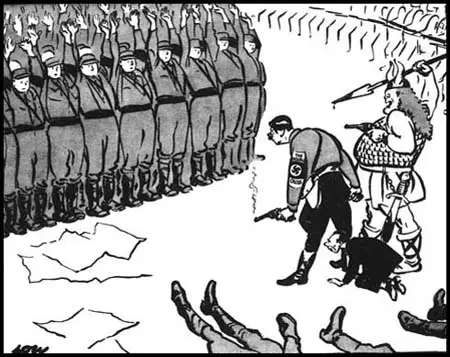
According to Paul R. Maracin, the author of The Night of the Long Knives: Forty-Eight Hours that Changed the History of the World (2004): "Ten minutes later, SS officers Michael Lippert and Theodor Eicke appeared, and as the embittered, scar-faced veteran of verdun defiantly stood in the middle of the cell stripped to the waist, the two SS officers riddled his body with revolver bullets." Eicke later claimed that Röhm fell to the floor moaning "Mein Führer". (58)
Aftermath
It is not known how many people were murdered between 30th June and 2nd July, when Hitler called off the killings. Hitler admitted to 76, but the real number is probably nearer 200 or 250. "Bodies were found in fields and woods for weeks afterwards and files of petitions from relatives of the missing remained active for months. What seems certain is that less than half were SA officers." (59)
Herman Rauschning argues that the Night of the Long Knives showed Hitler that the German Army posed no real threat to his government: "They had got their wish: Röhm was removed. The independence of the Reichswehr was assured. That was enough for them. They had no use for civil unrest. They reserved the right to make a special investigation into the shooting of the two generals, von Schleicher, the former Reich Chancellor, and von Bredow. They allowed their one opportunity of shaking off the National Socialist yoke to go by. Without political insight, uncertain and vacillating in everything except their military calling, they were anxious to return as quickly as possible to ordered and regular activities. This failure of the high officials and officers, and also of the big industrial and agricultural interests, was symptomatic of their further attitude. They were no longer capable of any statesmanlike action. In every crisis, they would again be in the opposition, but would always recoil before the final step, the overthrow of the regime." (60)
Hitler told Albert Speer what happened at Bad Wiesse: "Hitler was extremely excited and, as I believe to this day, inwardly convinced that he had come through a great danger. Again and again he described how he had forced his way into the Hotel Hanselmayer in Wiessee - not forgetting, in the telling, to make a show of his courage: We were unarmed, imagine, and didn't know whether or not those swine might have armed guards to use against us. The homosexual atmosphere had disgusted him: In one room we found two naked boys! Evidently he believed that his personal action had averted a disaster at the last minute: I alone was able to solve this problem. No one else! His entourage tried to deepen his distaste for the executed SA leaders by assiduously reporting as many details as possible about the intimate life of Röhm and his following." (61)
The purge of the SA was kept secret until it was announced by Hitler on 13th July. It was during this speech that Hitler gave the purge its name: "Night of the Long Knives" (a phrase from a popular Nazi song). Hitler claimed that 61 had been executed while 13 had been shot resisting arrest and three had committed suicide. Others have argued that as many as 400 people were killed during the purge. In his speech Hitler explained why he had not relied on the courts to deal with the conspirators: "In this hour I was responsible for the fate of the German people, and thereby I become the supreme judge of the German people. I gave the order to shoot the ringleaders in this treason."

Sidney Strube, Daily Express (3rd July, 1934)
Heinrich Himmler made a speech to Gestapo officials on 11th October, 1934: "For us as Secret State Police and as members of the SS, 30 June was not - as several believe - a day of victory or a day of triumph, but it was the hardest day that can be visited on a soldier in his lifetime. To have to shoot one's own comrades, with whom one has stood side by side for eight or ten years in the struggle for an ideal, and who had then failed, is the bitterest thing which can happen to a man. For everyone who knows the Jews, freemasons and Catholics, it was obvious that these forces - who in the final analysis caused even 30 June in so much as they sent numerous individuals into the SA and the entourage of the former Chief of Staff and drove him to catastrophe - these forces were very much annoyed at the rout on 30 June. Because 30 June signified no more and no less than the detonation of the National Socialist state from within, blowing it up with its own people. There would have been chaos, and it would have given a foreign enemy the possibility of marching into Germany with the excuse that order had to be created in Germany." (62)
SA and Anti-Semitism
Once in power Adolf Hitler began to openly express anti-Semitic ideas. Based on his readings of how blacks were denied civil rights in the southern states in America, Hitler attempted to make life so unpleasant for Jews in Germany that they would emigrate.SA members hunted down Jews in Berlin and gave them savage beatings. Synagogues were trashed and all over Germany gangs of brownshirts attacked Jews. In the first three months of Hitler rule, over forty Jews were murdered. (63)
Hitler announced a boycott of Jewish businesses. Members of the SA picketed the shops to ensure the boycott was successful. As a child Christa Wolf watched the SA organize the boycott of Jewish businesses. "A pair of SA men stood outside the door of the Jewish shops, next to the white enamel plate, and prevented anyone who could not prove that he lived in the building from entering and baring his Aryan body before non-Aryan eyes." (64)
Armin Hertz was only nine years old at the time of the boycott. His parents owned a furniture store in Berlin. "After Hitler came to power, there was the boycott in April of that year. I remember that very vividly because I saw the Nazi Party members in their brown uniforms and armbands standing in front of our store with signs: "Kauft nicht bei Juden" (Don't buy from Jews). That of course, was very frightening to us. Nobody entered the shop. As a matter of fact, there was a competitor across the street - she must have been a member of the Nazi Party already by then - who used to come over and chase people away." (65)
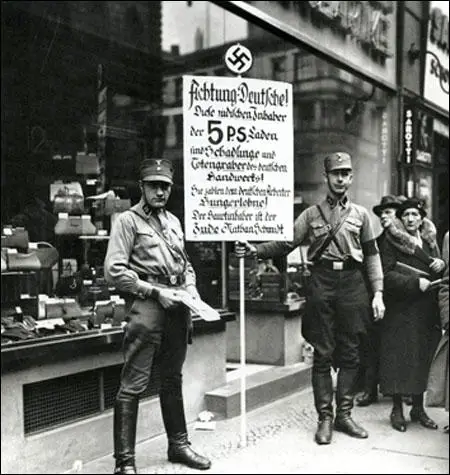
the German economy and pay their German employees starvation wages.
The main owner is the Jew Nathan Schmidt.” (1st April, 1933)
Helga Schmidt was only 12 years old when Adolf Hitler came to power. She remembers at school in Dresden that German children were encouraged to hate the Jews. "Certainly there was something of a negative attitude toward the Jews, but before Hitler it did not exist to the same extent. One tolerated them. One let them live. There was never any particular sympathy for the Jews. But to directly label them as our enemies and exploiters, that came from Hitler... and when that has been pounded into people's heads, people will also believe it." However, Helga and her family continued to shop in them "because they were less expensive than other stores." (66)
The hostility towards Jews increased in Nazi Germany. This was reflected in the decision by many shops and restaurants not to serve the Jewish population. Placards saying "Jews not admitted" and "Jews enter this place at their own risk" began to appear all over Germany. In some parts of the country Jews were banned from public parks, swimming-pools and public transport. (67)
The number of Jews emigrating increased after the passing of the Nuremberg Laws on Citizenship and Race in 1935. The first Reich Law of Citizenship divided people in Germany into two categories. The citizen of "pure German blood" and the rest of the population. The Law for the Protection of German Blood and Honour forbade intermarrying between the two groups. Some 250 decrees followed these laws. These excluded Jews from official positions and professions. They were also forced to wear the "Star of David". (68)
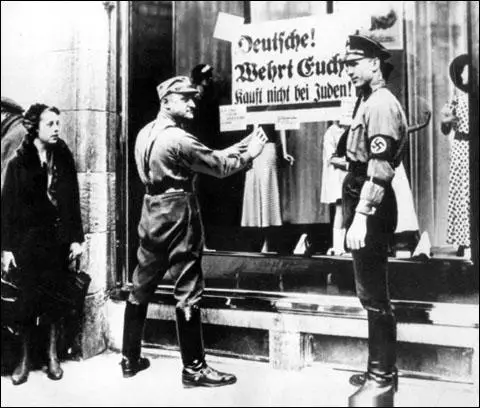
Christa Wolf remembers hearing Joseph Goebbels give a speech on the radio in 1937 about the Jews: "Without fear we may point to the Jew as the motivator, the originator, and the beneficiary of this horrible catastrophe. Behold the enemy of the world, the annihilator of cultures, the parasite among nations, the son of chaos, the incarnation of evil, the ferment of decay, the formative demon of mankind's downfall." She grew up believing that the "Jews are different from us... Jews must be feared, even if one can't hate them." (69)
Josef Stone went to a Jewish school to avoid bullying but he was still targeted by German children while playing in the streets of Frankfurt: "Germans looked at Jews in a sort of bad way.... Children always gave me a hard time. They wouldn't hit me, they just annoyed me with words and yelled obscene things at me. But, at that time, I was too young to even fathom the whole idea. I didn't really get involved until I would say thirteen or fourteen. By that time I started realizing what really was going on, and my parents started to say that eventually we would all have to leave." (70)
Members of the SA put pressure on people not to buy goods produced by Jewish companies. For example, the Ullstein Verlag, the largest publisher of newspapers, books and magazines in Germany, was forced to sell the company to the NSDAP in 1934 after the actions of the SA had made it impossible for them to make a profit. Germans were also encouraged not to use Jewish doctors and lawyers. Jewish civil servants, teachers and those employed by the mass media were sacked. In the 12 months of Hitler taking power, over 40,000 Jewish people left Germany. (71)
Victor Lutz
Victor Lutze had helped Adolf Hitler carry out the Night of the Long Knives. He was appointed as the new leader of the SA. The Schutz Staffeinel (SS) under the leadership of Heinrich Himmler grew rapidly during the next few years, replacing the SA as the dominant force in Germany. Its main role in Nazi Germany was to make life difficult for the Jews and to give part-time military training. (72)
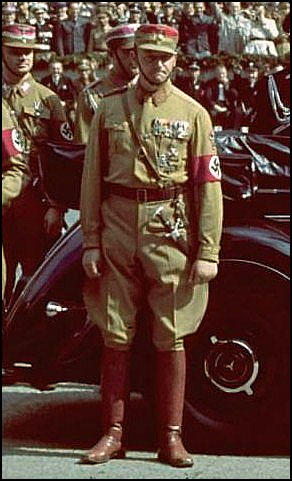
Ernst Röhm was replaced by Victor Lutze as head of the SA. Lutze was a weak man and the SA gradually lost its power in Hitler's Germany. The Schutz Staffeinel (SS) under the leadership of Himmler grew rapidly during the next few years, replacing the SA as the dominant force in Germany.
Joseph Goebbels made a speech pointing out that the SA was still an important force in the country. "The SA is an historic fact and no one can imagine its disappearance. There are some organizations which act simply by their presence." He claimed that the existence of the SA would help prevent war. (73) Hitler added that the SA was to maintain internal order, just as the armed forces were required to provide external order. (74)
It was decided to hold a Great German Art Exhibition in Munich. Adolf Ziegler, signed the announcement for the competition. "All German artists in the Reich and abroad" were invited to participate. The only requirement for entering the competition was German nationality or "race". After extending the deadline for submissions, 15,000 works of art were sent in, and of these about 900 were exhibited. According to official records, the exhibition had 600,000 visitors. (75) Hubert Wilm, a pro-Nazi artist, explained what they were trying to achieve: “Representation of the perfect beauty of a race steeled in battle and sport, inspired not by antiquity or classicism but by the pulsing life of our present-day events”. (76)
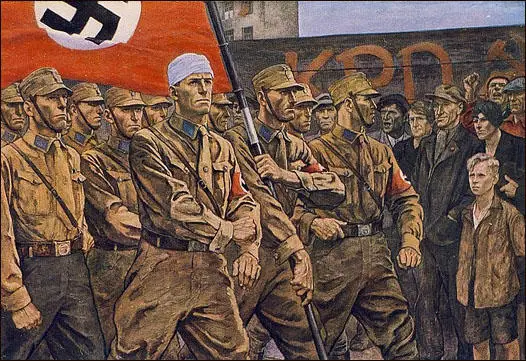
Elk Eber, a former member of the SA showed The Last Grenade at the Great German Exhibition in 1937. The following year he exhibited his most famous painting, This Was the SA. " Eber's composition who was the SA was exhibited in Munich showing a march of a SA troop under a swastika banner, a man in the foreground with his head bandaged, and curious onlookers on the side, among them an admiring young boy - in what was most certainly to be a Berlin Communist stronghold in the last republic." (77) Hitler was so impressed with the painting he purchased it for 12,000 RM. (78) Over the next few years a total of 16 of his oil paintings were shown at the annual Great German Art Exhibition. (79)
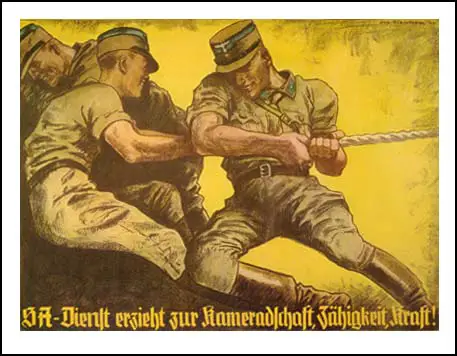
During the Second World War the SA had a role in air-raid duties. The International Military Tribunal at Nuremberg decided that the SA was not guilty of war crimes: "Up until the purge beginning on June 30, 1934, the SA was a group composed in large part of ruffians and bullies who participated in the outrages of that period. It has not been shown, however, that these atrocities were part of a specific plan to wage aggressive war, and the Tribunal therefore cannot hold that these activities were criminal under the Charter. After the purge the SA was reduced to the status of unimportant Nazi hangers-on."
Primary Sources
(1) Rudolf Olden, Hitler the Pawn (1936)
The SA began to terrorise entire cities... Meetings were announced on huge red placards, with terrific slogans. Lorry-loads of yelling young bullies, waving swastikas on a red background, would tear through the town, flinging handbills into the streets. Every entrance to the meeting was guarded by groups of these violent young men.... The Storm Troops march into hall with the monotonous even step of the Prussian battalions. A band commands silence. He appears, surrounded by a bodyguard of the tallest of his dangerous, and dangerous-looking, lads. He (Hitler) is greeted with the enthusiastic cries of well-practised supporters. Everything is done with a view to impressing newcomers and the half-converted; all is designed to fill the masses with the shudder of pleasure which a display of superior strength inevitably arouses in weak souls."
Hitler despised the campaigning methods favoured by democratic parties. With them, he says, " this guarding of the hall, or rather stewards' service, was usually performed by men who thought that, on the strength of their advanced age, they had some claim to authority and respect." He, on the other hand, picked out bullies and rowdies, all of them young fellows with a natural leaning to violence. It was impressed on them that "terror could only be broken by terror." Each of them knew, when an opponent called out "Freiheit" at their meetings, that that constituted "Marxist terror" and had to be "broken" on the spot. "They were steeped in the doctrine that, when reason is silenced, and the final decision lies with violence, the best weapon of defence lies in attack, and that our band of stewards had everywhere to be preceded by its reputation for being, not a debating society, but a determined band of fighters." That violence decides not only in the closing stages, but from the very beginning of an action, was - and the "stewards" well knew it-the basic teaching of their Leader...
Hitler despised the campaigning methods favoured by democratic parties. With them, he says, "this guarding of the hall, or rather stewards' service, was usually performed by men who thought that, on the strength of their advanced age, they had some claim to authority and respect." He, on the other hand, picked out bullies and rowdies, all of them young fellows with a natural leaning to violence. It was impressed on them that "terror could only be broken by terror." Each of them knew, when an opponent called out "Freiheit" at their meetings, that that constituted "Marxist terror" and had to be "broken" on the spot. They were steeped in the doctrine that, when reason is silenced, and the final decision lies with violence, the best weapon of defence lies in attack, and that our band of stewards had everywhere to be preceded by its reputation for being, not a debating society, but a determined band of fighters. That violence decides not only in the closing stages, but from the very beginning of an action, was - and the "stewards" well knew it - the basic teaching of their Leader.
(2) Paul R. Maracin, The Night of the Long Knives: Forty-Eight Hours that Changed the History of the World (2004)
After the war a large arsenal was left by the German Army, and Röhm was one of several officers who conspired to divert and cache the arms. The German government had promised the Allies that the guns, ammunition, and vehicles would be dutifully destroyed, and according to the peace treaty, this should have been done. However, in some instances (with the connivance of some Allied officers attached to control commissions), these arms were stored for future use and would later he issued to members of the Freikorps and the SA. As an officer, Röhm had the reputation of a man who resolutely stood by his subordinates, while acting as a buffer between them and his superior officers. For all his dedication as a soldier, he was, paradoxically, a person who casually arranged for the murder of informants who tried to reveal the whereabouts of his hidden arsenals.
It was Röhm - not Hitler - who first stumbled across the German Workers' Party, and it was Röhm who transformed that "talking club" (as one early writer described it) into a viable, fermenting hotbed of activists. It was Rohm who provided the infusion of restless, action-seeking (and action-producing) soldiers and former soldiers, thereby changing the original working-class character of the party. Röhm was already a member when Hitler discovered the party in the fall of 1919. He was impressed with Hitler's oratory, and was instrumental in putting Hitler in touch with politicians and military personnel who could be useful to the party. Without this assistance, it is doubtful that Hitler's political star could have risen so quickly.
The genesis of the SA dates back to the summer of 1920, when Emil Maurice, an ex-convict who later became Hitler's personal chauffeur, was placed in charge of a motley group of unruly party protectors. As a camouflage, in August 1921, they were called the "Gymnastic and Sports Division" of the party, and this transparent attempt to conceal the true purpose of the division was continued until October 1921 when it became known as the SA. Röhm was always the guiding light behind the SA, and it was his influence that brought in the militaristic recruits, his fine hand and expertise that restructured the SA into the formidable force it became in later years. It was Hitler who spouted the words; it was Röhm and his SA who provided the brawn to back them up.
During the latter part of September 1923, Rohm resigned from the Reichswehr and devoted all of his time to Hitler and the cause. Less than two months later he was deeply involved in the Beer Hall Putsch. He was the only leader in the coup d'etat who accomplished his objective: to seize the headquarters of the army at the War Ministry in Munich. Two hours after Hitler's march through the streets had been halted and dispersed by police bullets, Röhm realized the futility of the operation, surrendered, and was placed under arrest. He was one of the ten defendants tried for treason.
While Hitler was sent to Landsberg Prison, Röhm (although found guilty) was placed on probation and released. He now entered the most difficult period of his life. While Hitler was serving his sentence, he and Gregor Strasser aligned themselves with the recently formed National Socialist Freedom Movement and won themselves seats in the Reichstag in the May 1924 election. Other than that accomplishment, it was all downhill. During 1924 Röhm endured the embarrassment of having his suitcase and personal papers stolen while he was consorting with questionable acquaintances in a sordid section of Berlin; as a result of this indiscretion, his homosexual proclivities became known to police authorities.
In April 1925 he had a falling-out with Hitler, withdrew from political life, and failed miserably in his efforts to support himself. He drifted about, worked for a short period at a machine factory, became a book salesman, and imposed on his homosexual friends for sustenance. As a civilian, he was totally out of his element. At one time he had frankly acknowledged that "war and unrest appeal to me more than the orderly life of your respectable burgher." But, respectable burgher he was not; virtually destitute, he moved about in the lowest of circles and associated with the dregs of the social stratum. He had also once made the statement that he could "reach an understanding more easily with an enemy soldier than with a German civilian, because the latter is a swine and I don't understand his language." He now found himself living as "a swine."
In 1928 he briefly reconciled with Hitler and traveled throughout Germany renewing contacts with active duty Reichswehr officers as the party chief's envoy. After yet another dispute with Hitler, he abruptly left Germany for South America, accepting the post of military adviser to the Bolivian Army as a lieutenant-colonel. From Bolivia he imprudently sent letters to friends in Germany in which he decried the lack of understanding for homosexuals in that faraway land. Some of the letters addressed to Dr. Karl-Gunther Heimsoth fell into the hands of newspaper journalists and were given wide-spread publicity.
With Röhm in South America, Hitler placed Captain Franz Pfeffer von Salomon in charge of the SA. This was a move Hitler came to regret, as Pfeffer von Salomon (like Rohm) had an independent mind, but unlike Rohm had no fealty to Hitler, who he characterized as "that flabby Austrian."
By August 1930 Hitler had reached the end of his patience with Pfeffer von Salomon. He relieved him of his command and, on an interim basis, personally assumed leadership of the SA. A telegram was dispatched from Munich to La Paz, as once again Hitler in a time of need turned to the man who had been so essential to him in past days of travail. By the end of 1930 Rohm had returned to his native Germany, and in January 1931 he was named Chief of Staff of the SA.
He immediately began the task of rebuilding and enlarging the SA, and in so doing brought his homosexual friends into leadership positions. Hitler turned aside all complaints about Rohm's morals, lifestyle, methods, and techniques, and defended the SA by saying it was "not an institute for the moral education of young ladies but a band of tough fighters." And so it was, as the ranks burgeoned to encompass the criminal element as well as sundry undesirables.
This was all done with the acquiescence of Hitler, but to the dismay of Reichswehr leaders, who viewed Rohm and his men as distinct threats to displacing the army as the Fatherland's first line of defense. The Treaty of Versailles limited the Reichswehr to a force of 100,000. No such restriction applied to the SA, which operated somewhat like the National Guard in the United States, with many members holding full-time civilian jobs.
With the responsibility of the SA firmly in Röhm's hands, Hitler concentrated on his final push toward his goal. By the time he negotiated his power play to snatch the chancellorship from under the very noses of von Schleicher and von Papen, Röhm had molded the SA into an intimidating strike force. Hitler's private army was ready and eager to be tested. Thanks to Rohm-who had again done his job-Hitler could operate from a position of strength.
(3) Ernst Röhm, article published about Adolf Hitler becoming Chancellor of Germany (June, 1933)
A tremendous victory has been won. But not an absolute victory! The SA and the SS will not tolerate the German revolution going to sleep and being betrayed at the half-way stage by non-combatants. Not for the sake of the SA and SS but for Germany's sake. For the SA is the last armed force of the nation, the last defence against communism. If the German revolution is wrecked by the reactionary opposition, incompetence, or laziness, the German people will fall into despair and will be an easy prey for the bloodstained frenzy coming from the depths of Asia.
If these bourgeois simpletons think that the national revolution has already lasted too long, for once we agree with them. It is in fact high time the national revolution stopped and became the National Socialist one. Whether they like it or not, we will continue our struggle - if they understand at last what it is about - with them; if they are unwilling - without them; and if necessary - against them.
(4) Ernst Röhm, announcement to the Sturm Abteilung (SA) (May, 1934)
1934 will require all the energies of every SA fighter. I recommend, therefore, to all SA leaders to begin organizing leave already in June. Therefore, for a limited number of SA leaders and men, June, and for the majority of the SA, July, will be a period of complete relaxation in which they can recover their strength. I expect the SA to return on 1st August completely rested and refreshed in order to serve in those honourable capacities which nation and fatherland expect of it.
Student Activities
Adolf Hitler's Early Life (Answer Commentary)
Adolf Hitler and the First World War (Answer Commentary)
Adolf Hitler and the German Workers' Party (Answer Commentary)
Sturmabteilung (SA) (Answer Commentary)
Adolf Hitler and the Beer Hall Putsch (Answer Commentary)
Adolf Hitler the Orator (Answer Commentary)
An Assessment of the Nazi-Soviet Pact (Answer Commentary)
British Newspapers and Adolf Hitler (Answer Commentary)
Lord Rothermere, Daily Mail and Adolf Hitler (Answer Commentary)
Adolf Hitler v John Heartfield (Answer Commentary)
The Hitler Youth (Answer Commentary)
German League of Girls (Answer Commentary)
Night of the Long Knives (Answer Commentary)
The Political Development of Sophie Scholl (Answer Commentary)
The White Rose Anti-Nazi Group (Answer Commentary)
Kristallnacht (Answer Commentary)
Heinrich Himmler and the SS (Answer Commentary)
Trade Unions in Nazi Germany (Answer Commentary)
Hitler's Volkswagen (The People's Car) (Answer Commentary)
Women in Nazi Germany (Answer Commentary)
